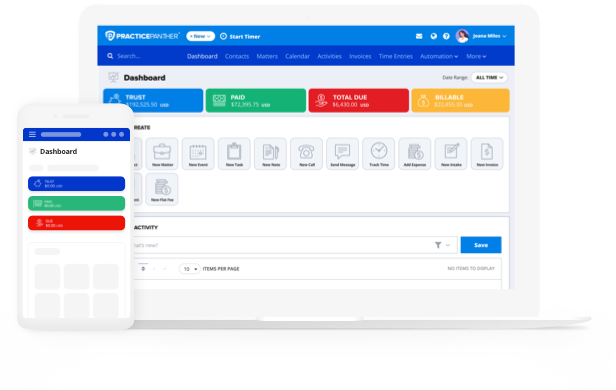A key component of a job is the work that’s assigned every day. In a law firm, that usually means partners are assigning work to associates and choosing the best candidates for the most important tasks. However, to effectively manage law firm work allocation, work should be distributed as evenly as possible without burdening or underutilizing the team.
In a fast-paced and demanding legal industry, these tasks can come from anywhere (and out of nowhere), such as late-night emails, after-hours voicemails and calls, social media messages, and more. This is not only inefficient but sets associates up for failure if they happen to miss a critical task while managing multiple communication outlets.
In addition, some tasks are allocated to non-lawyer staff members, such as legal support staff or business, marketing, or accounting staff. This can create information silos that disrupt workflows and negatively impact both employees and the firm’s success.
For both the firm and the associates alike, it’s vital to create systems to distribute work and ensure employee satisfaction. Here are some tips to manage law firm work allocation:
- Plan Availiabilty and Workloads
- Track Development Needs
- Strategize Law Firm Work Allocation
- Support ongoing Development
- Divide Tasks Evenly
- Balance Workloads Across Departments
1. Plan Availability and Workloads
As mentioned, work allocation usually involves assigning high-priority tasks to the most suitable candidates, which can cause disproportionate workloads and possible burnout. Effective work allocation requires real-time visibility into staff availability and current workloads, especially in large firms.
It can be easy to dump an unrealistic amount of work on only a few staff members, not realizing they’re already overloaded with tasks from others. Ideally, associates and other staff members should update the firm on their availability, whether weekly or daily, so management and partners can ensure that work is allocated appropriately.
2. Track Development Needs
While it may make sense to assign critical work to the most capable staff, this can create skill and experience gaps in other associates. It’s vital for law firms to have a comprehensive view of the skills each associate has and the ones they need to work on, ensuring that work allocation is evenly distributed and develops each associate’s skill.
If there are significant gaps in skills, law firms should take a proactive approach to correct them. For example, all associates and staff members should have basic management training, client training, and business development training. Associates should have development in areas specific to the practice groups and the firm’s goals. Firms can also designate partners, teams, or mentor relationships to ensure that less-skilled associates can develop their skills with the necessary guidance and supervision.
3. Strategize Law Firm Work Allocation
Once partners and management have comprehensive information on availability and skills, they can make strategic decisions on work allocation and assign the most beneficial and effective staff members. For example, a partner may request a task and then search for the most qualified and available colleagues, rather than just assigning work blindly.
A centralized law practice management software, like PracticePanther, can be an asset in this situation. Partners and managers can browse associate and staff tasks or stages in a workflow to get real-time availability and delegate accordingly.
4. Support Ongoing Development
Along with firmwide competencies, it’s important for law firms to support ongoing employee development to attract and retain the best talent. When a firm invests in its associates, they create an environment in which young talent can flourish. In return, these associates will be more loyal to their firm and dedicated to its larger business goals.
5. Divide Tasks Evenly
Historically, law firm work allocation has been driven by partner-associate relationships. Associates understand that the best opportunities come from building relationships with partners, and the partners tend to assign work to them disproportionately as a result. This is not only unsustainable in the long term, but denies other associates a chance to learn, grow, and contribute.
With a law practice management platform in place, law firms can consider the quantity and type of work that’s assigned to associates. With this full-picture view, management can make sure that associates are given opportunities to develop all competencies and that no associates are overloaded with an unreasonable amount of work.
This also helps with firm resources. Having overutilized employees can lead to burnout and attrition, and conversely, underutilized employees are a waste of resources and may seek more beneficial opportunities. With law firms struggling to attract and retain top talent, no one can afford to let good candidates slip through the cracks.
6. Balance Workloads Across Departments
Law firm work allocation can be more challenging in large law firms, especially if they have multiple offices and practice groups. If the law firm is diverse in this way, it’s important for the work allocation to be managed by all applicable groups. It’s virtually impossible for one office or practice group to efficiently determine the availability and qualifications firmwide.
Work allocation should take place across the firm, offices, and practice groups. If necessary, law firms should consider adding to the staff to support their work allocation needs and create more effective systems of assigning work to the appropriate associates. For example, a work allocation manager can ensure that work is assigned strategically and manage workflows across different firm offices or practice areas.
Streamlining Law Firm Work Allocation
Law firms may struggle with work allocation, but streamlining and systemizing the processes can ensure that work is delegated evenly. For larger firms, it may be beneficial to assign work allocation managers that are in charge of monitoring availability, qualifications, skills, resources, and work distribution.
Technology can go a long way in supporting work allocation, whether with a dedicated work allocation manager or not. PracticePanther provides comprehensive views of associates and other staff, communications, task management, and workflows to support more systemized work allocation, even in the busiest of law firms.




